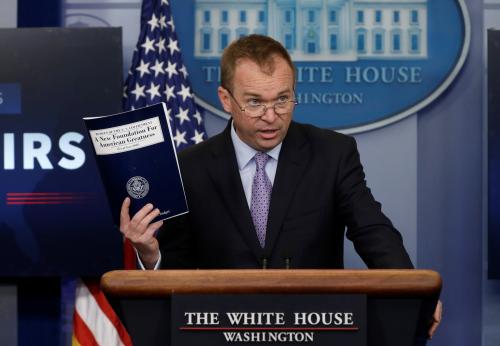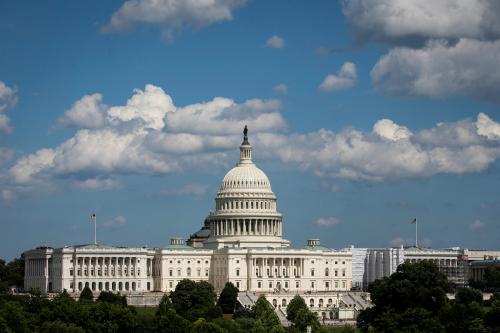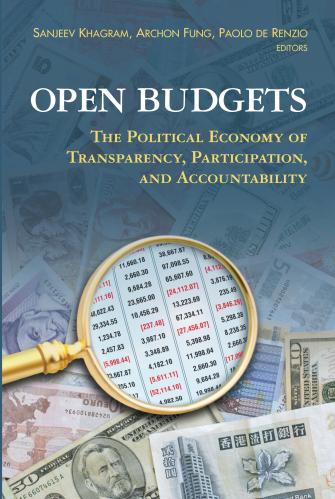This week, the Senate passed a four-bill spending package addressing funding for the Departments of the Interior, Agriculture, Transportation, and Housing and Urban Development as well as a number of other government agencies. In the coming weeks, the chamber may bring up a combined spending bill for the Departments of Defense, Labor, Health and Human Services, and Education. These bills follow one passed by the Senate earlier in the summer to fund military construction, energy, and water projects as well as the VA and Congress’s own operations. Dubbed the “minibus” strategy, this choice to combine separate spending bills into a few, larger packages has been at the center of Congress’s efforts to keep the government funded this year.
With two minibuses containing seven separate bills under its belt and a third covering two more on deck, the Senate is already poised to do better at passing its version of component appropriations bills before September 30 than it has in recent years. In 2010, 2012, 2013, 2014, 2015, and 2017, the Senate failed to adopt its version of any standalone appropriations bills before the September 30 deadline. In 2016, the Senate passed three measures—the Energy and Water bill and one combining the Military Construction-VA and Transportation-HUD titles—while in 2011, it passed only the Military Construction-VA bill. The last year that the Senate registered a performance similar to this year’s was under unified Democratic government with a near filibuster-proof majority in 2009, when it completed its initial work on 6 of its 12 bills before the end of the fiscal year.
The Senate has needed the minibus strategy to rack up this year’s strong record, however; while using fewer, combined bills has allowed the chamber to get more work done, it does represent a departure from the letter of the process, which calls for separate deliberation on a series of individual bills. But the number of distinct measures wasn’t handed down, Moses-style, on a tablet—it has changed over time in response to the political and policy realities facing Congress.
The modern organization of the appropriations process dates to 1921 and the passage of the Budget and Accounting Act. In conjunction with the act—meant in part to give more power to the president through a centralized budget process—the House consolidated appropriations jurisdiction in the hands of the Appropriations Committee and created a set of administratively organized subcommittees. (The Senate followed suit with a similar reorganization in 1922.) Prior to this reorganization, a range of committees had authority over spending decisions. These committees would make decisions about actual agency activities, such as how much to spend on the War Department. But choices about how to allocate money for the salaries of the officials who carried out those programs were made separately—sometimes by an entirely different committee.
The choice to organize Congress’s appropriations functions administratively, rather than topically, meant that as the federal government grew and changed in the 1940s and 1950s, the structure of the Appropriations Committees followed suit. A period of relative stability lasted from the early 1970s until the early 2000s, when a subcommittee to handle the new Department of Homeland Security was created in both chambers in 2003. The House saw a short-lived reduction in the number of appropriations subcommittees to 10 in the 109th Congress (2005-06) after a push from House Majority Leader Tom DeLay to realign the panels in accordance with GOP spending priorities. After Democrats retook control of the House in 2007, they returned to 12 subcommittees, and both chambers have kept that structure since then.
Even if there’s consensus around dividing the discretionary pie into 12 separate pieces for the purposes of bill development, it does not automatically follow that 12 is the optimal number of components for the purposes of floor deliberation and passage. Organizing the process in different ways elevates different values over others. Take predictability, or the notion that “the budget process should be completed according to meaningful and achievable deadlines;” this was among the nine principles for a better budget process articulated in a recent report from a diverse group of federal budget stakeholders convened by the Convergence Center for Policy Resolution. If we think timeliness is important, then bringing only one or a few spending bills to the floor of the chamber has real advantages; not only does it reduce the number of bills to which floor time must be devoted, but it also allows for more extensive logrolling in order to make passage easier. The logic behind the Senate’s aggregation of the Labor-Health and Human Services-Education measure with its Defense title, for example, is that combining something that’s traditionally a Democratic priority with something thought to be a Republican one, it will reduce barriers to passage.
But timeliness is just one value that the appropriations process might embrace. A second could be the opportunity for rank-and-file members to offer their own floor amendments to spending bills—a principle we might call “open deliberation.” Providing more chances for input from individual legislators requires both floor time and the capacity for members to analyze and digest the specific components of a spending measure they might want to change. In that case, fewer bills are better.
Given the difficulty that the House and Senate are having thus far reaching a compromise on the combined Energy-Water/Military Construction-VA/Legislative Branch bill, it’s entirely possible that the minibus strategy does little to increase Congress’s actual appropriations output this year. But even if that’s the case, the decision to try to move spending bills in smaller packages illustrates something important about the appropriations process: to make it work better, reformers must first confront hard questions about what the process should do.










Commentary
The Senate passed another “minibus” funding package. Now what?
August 2, 2018